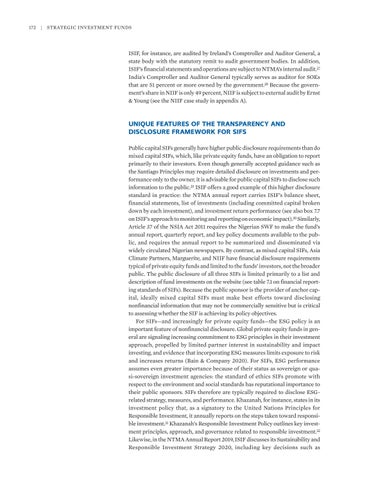172
| Strategic Investment Funds
ISIF, for instance, are audited by Ireland’s Comptroller and Auditor General, a state body with the statutory remit to audit government bodies. In addition, ISIF’s financial statements and operations are subject to NTMA’s internal audit.27 India’s Comptroller and Auditor General typically serves as auditor for SOEs that are 51 percent or more owned by the government.28 Because the government’s share in NIIF is only 49 percent, NIIF is subject to external audit by Ernst & Young (see the NIIF case study in appendix A).
UNIQUE FEATURES OF THE TRANSPARENCY AND DISCLOSURE FRAMEWORK FOR SIFS Public capital SIFs generally have higher public disclosure requirements than do mixed capital SIFs, which, like private equity funds, have an obligation to report primarily to their investors. Even though generally accepted guidance such as the Santiago Principles may require detailed disclosure on investments and performance only to the owner, it is advisable for public capital SIFs to disclose such information to the public.29 ISIF offers a good example of this higher disclosure standard in practice: the NTMA annual report carries ISIF’s balance sheet, financial statements, list of investments (including committed capital broken down by each investment), and investment return performance (see also box 7.7 on ISIF’s approach to monitoring and reporting on economic impact).30 Similarly, Article 37 of the NSIA Act 2011 requires the Nigerian SWF to make the fund’s annual report, quarterly report, and key policy documents available to the public, and requires the annual report to be summarized and disseminated via widely circulated Nigerian newspapers. By contrast, as mixed capital SIFs, Asia Climate Partners, Marguerite, and NIIF have financial disclosure requirements typical of private equity funds and limited to the funds’ investors, not the broader public. The public disclosure of all three SIFs is limited primarily to a list and description of fund investments on the website (see table 7.1 on financial reporting standards of SIFs). Because the public sponsor is the provider of anchor capital, ideally mixed capital SIFs must make best efforts toward disclosing nonfinancial information that may not be commercially sensitive but is critical to assessing whether the SIF is achieving its policy objectives. For SIFs—and increasingly for private equity funds—the ESG policy is an important feature of nonfinancial disclosure. Global private equity funds in general are signaling increasing commitment to ESG principles in their investment approach, propelled by limited partner interest in sustainability and impact investing, and evidence that incorporating ESG measures limits exposure to risk and increases returns (Bain & Company 2020). For SIFs, ESG performance assumes even greater importance because of their status as sovereign or quasi-sovereign investment agencies: the standard of ethics SIFs promote with respect to the environment and social standards has reputational importance to their public sponsors. SIFs therefore are typically required to disclose ESGrelated strategy, measures, and performance. Khazanah, for instance, states in its investment policy that, as a signatory to the United Nations Principles for Responsible Investment, it annually reports on the steps taken toward responsible investment.31 Khazanah’s Responsible Investment Policy outlines key investment principles, approach, and governance related to responsible investment.32 Likewise, in the NTMA Annual Report 2019, ISIF discusses its Sustainability and Responsible Investment Strategy 2020, including key decisions such as

